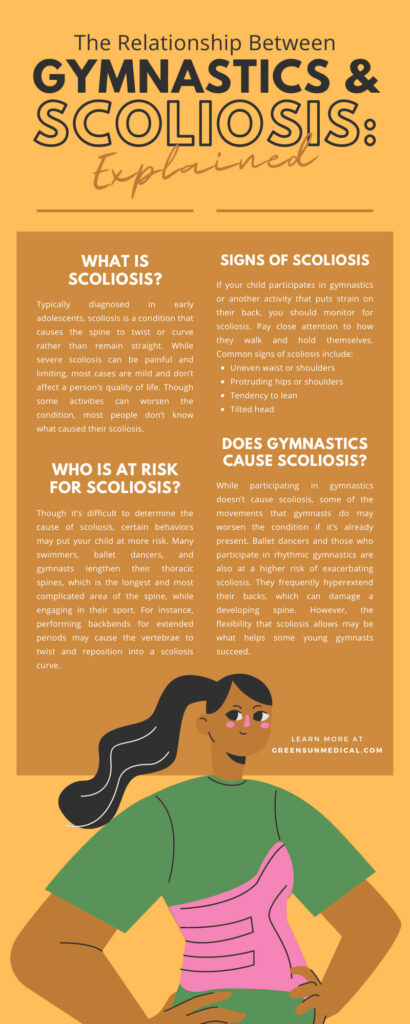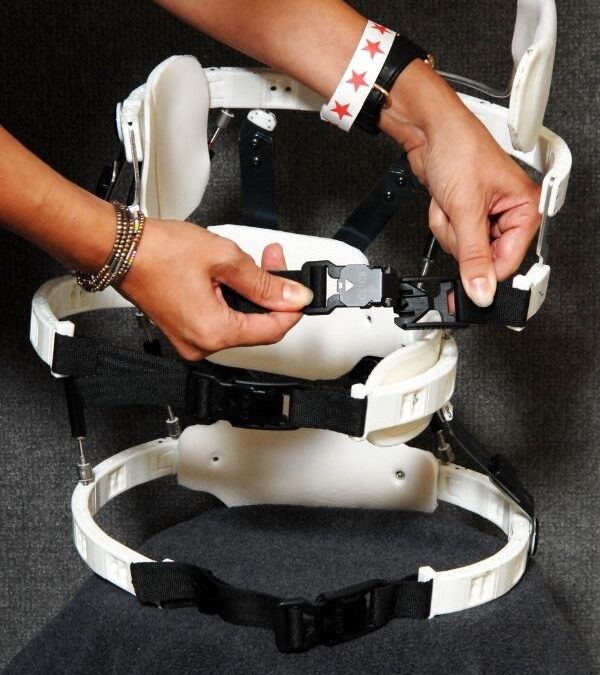The more flexible you are, the more likely it is that you’ll be attracted to sports and exercises that allow you to use your skills—such as gymnastics. The relationship between gymnastics and scoliosis isn’t easily explained since there isn’t a direct correlation. Still, many people who do gymnastics have a curve in their spines.
Children begin to discover their flexibility at a young age and may be naturally inclined to try movements that stretch their spines. While many kids love activities like swimming, dancing, and gymnastics, the way they move their bodies may cause a spinal irregularity and future complications. Find out what you need to know about keeping your kid in gymnastics if they have scoliosis.
What Is Scoliosis?
Typically diagnosed in early adolescents, scoliosis is a condition that causes the spine to twist or curve rather than remain straight. While severe scoliosis can be painful and limiting, most cases are mild and don’t affect a person’s quality of life. Though some activities can worsen the condition, most people don’t know what caused their scoliosis.
Pro Tip: Scoliosis is hereditary, so keep a close eye on your child’s development if the condition runs in your family. You may not know if this is the case, since most cases are mild and may go undiagnosed.
Who Is at Risk for Scoliosis?
Though it’s difficult to determine the cause of scoliosis, certain behaviors may put your child at more risk. Many swimmers, ballet dancers, and gymnasts lengthen their thoracic spines, which is the longest and most complicated area of the spine, while engaging in their sport. For instance, performing backbends for extended periods may cause the vertebrae to twist and reposition into a scoliosis curve.
Other concerns for gymnasts with scoliosis include spinal compression. Falling on a hard floor isn’t good for a developing spine and may intensify the condition. Even running and walking can cause spinal compression if you apply too much strain to the back. Children shouldn’t stop participating in sports for fear of a spinal condition, though. Building up back strength is essential for good posture.
Signs of Scoliosis
If your child participates in gymnastics or another activity that puts strain on their back, you should monitor for scoliosis. Pay close attention to how they walk and hold themselves. Common signs of scoliosis include:
- Uneven waist or shoulders
- Protruding hips or shoulders
- Tendency to lean
- Tilted head
Does Gymnastics Cause Scoliosis?
While participating in gymnastics doesn’t cause scoliosis, some of the movements that gymnasts do may worsen the condition if it’s already present. Ballet dancers and those who participate in rhythmic gymnastics are also at a higher risk of exacerbating scoliosis. They frequently hyperextend their backs, which can damage a developing spine. However, the flexibility that scoliosis allows may be what helps some young gymnasts succeed.
Case by Case Basis
Though your child’s favorite activities aren’t the cause of their scoliosis, some movements can make it worse. Most children with scoliosis aren’t required to give up gymnastics. Still, you should seek the advice of a doctor if you begin to notice signs of a spinal abnormality. The sooner you intervene and seek treatment, the more likely it is that treatment will help.
Work With a Specialist
Get the best treatment when you work with a scoliosis specialist. They will determine the correct course of action and decide when your child should participate in sports. Most children are allowed to continue with an activity to keep their spine strong, though you may have to make modifications or decrease the amount of time spent on intense exercise.
Ensure you’re working with a good clinic before choosing a doctor. You’ll want to visit a facility in your area since your child may need X-rays throughout the year. The best clinics offer multiple treatment options and tailor them to your specific needs. Each case is different, and medical professionals shouldn’t treat them the same way. If your child has to wear a brace or undergo scoliosis correction surgery, work with a specialist who offers multiple options.
Talk to Your Gymnastics Instructor
If your child receives a scoliosis diagnosis, they should talk to their instructor about their options. Since the condition is common in children who do gymnastics, your teacher may have experience and know what to do. Work with them to find alternative poses and techniques, so your child’s spine doesn’t get worse.
Treatment for Scoliosis
Seek advice from a doctor as soon as you think your child may have a spinal condition. Many treatment options are available, though the main ones include monitoring and bracing. Most children will only require monitoring to ensure the curves in their spines don’t progress as they develop. Doctors will take X-rays to see if the angle of the curve is progressing and to determine if your child requires more intense treatment.
If your child requires bracing, you have many different options available. Most braces are designed for day use, while others are for use at night, such as the Charleston Bending Brace. Some are rigid while other braces are flexible, such as the Green Sun Medical Whisper Brace. Your doctor will recommend the best option for your child.
Another common treatment for scoliosis is physical therapy. The Schroth Method is designed to help patients improve their posture through a series of physical exercises that target an individual’s unique condition.
Conclusion
Though there isn’t a clear indication that gymnastics causes spinal abnormalities, it’s still important to understand the relationship between gymnastics and scoliosis. Though it hasn’t been completely explained, it’s possible that activities that lengthen the thoracic spine can contribute to the condition. Since gymnastics involves many backbends, intense running, and falls, it can worsen an already existing abnormality. Speak with a specialist if you’re concerned about your child’s spine. If they receive a diagnosis, work with your doctor to find a treatment that will work.
Every case is different and may require different methods. To learn more about scoliosis and which activities are safe for people with the condition, contact Green Sun Medical today.


